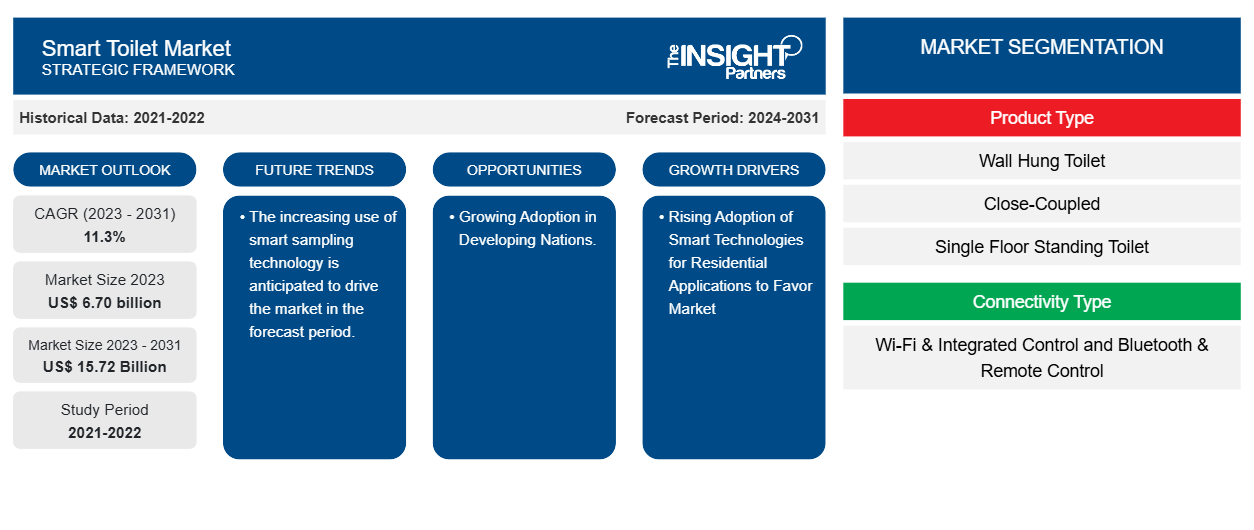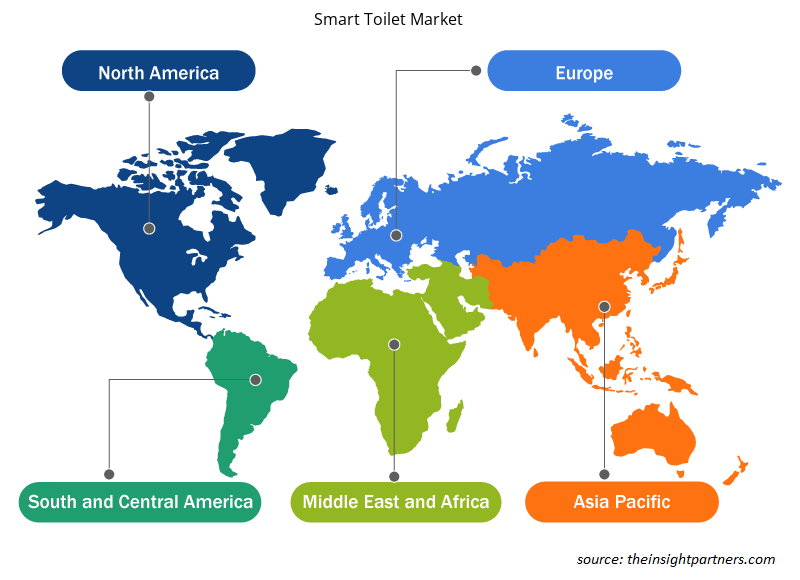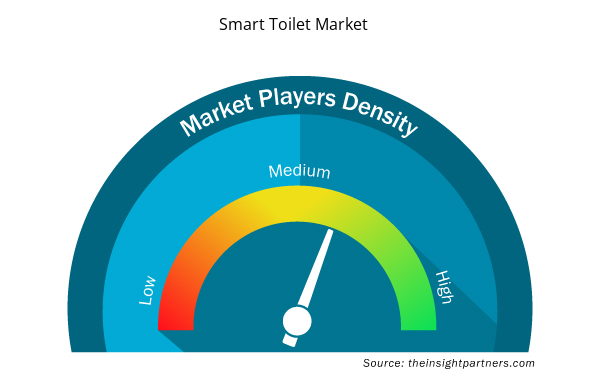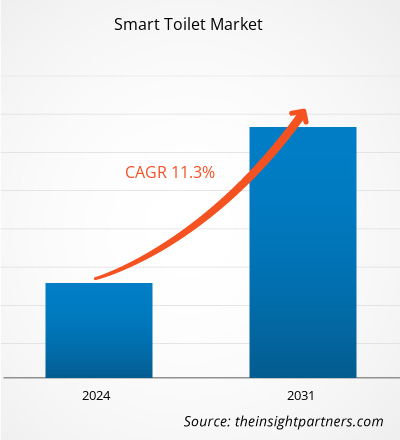The smart toilet market size is projected to reach US$ 15.72 billion by 2031 from US$ 6.70 billion in 2023. The market is expected to register a CAGR of 11.3% during 2023–2031. Rising adoption of smart technologies for residential applications, increasing installations of smart toilets in commercial spaces and growing demand for smart water-saving solutions are likely to be the key drivers and trends of the smart toilet market.
Smart Toilet Market Analysis
The smart toilet market is experiencing significant growth globally. This growth is attributed to the rising adoption of smart technologies for residential applications, increasing installations of smart toilets in commercial spaces and growing demand for smart water-saving solutions. Moreover, the rising adoption of smart toilets in developing countries growing smart toilets for home renovations is anticipated to drive the market growth in the coming years.
Smart Toilet Market Overview
A smart toilet is an advanced toilet using integrated-in smart technology or technology capable of connecting and interacting with the user. These toilets are often used in smart homes around the world and in technologically advanced regions such as Japan. Smart toilets come with a broad range of popular features, making them irresistible to some. These features include seat warmers, automatic lids, night lights, spray adjustments, and many more.
Customize This Report To Suit Your Requirement
You will get customization on any report - free of charge - including parts of this report, or country-level analysis, Excel Data pack, as well as avail great offers and discounts for start-ups & universities
Smart Toilet Market: Strategic Insights

- Get Top Key Market Trends of this report.This FREE sample will include data analysis, ranging from market trends to estimates and forecasts.
You will get customization on any report - free of charge - including parts of this report, or country-level analysis, Excel Data pack, as well as avail great offers and discounts for start-ups & universities
Smart Toilet Market: Strategic Insights

- Get Top Key Market Trends of this report.This FREE sample will include data analysis, ranging from market trends to estimates and forecasts.
Smart Toilet Market Drivers and Opportunities
Rising Adoption of Smart Technologies for Residential Applications to Favor Market
The rising adoption of smart technologies for residential applications is indeed driving the smart toilet market. The market is driven by factors rising consumer awareness, improved convenience and comfort, health and hygiene benefits, energy and water efficiency, integration with the smart home ecosystem, aging population, urbanization and luxury housing trends, innovative product offerings and many other factors. Consumers are becoming more aware of the benefits of smart devices, including smart toilets, as smart home technologies become more common. Moreover, the smart toilet has various features, such as automated cleaning, bidet functions, and heated seats. These conveniences create desires for modern consumers for greater comfort and luxury in their homes. Thus, considering the above parameters, the rising adoption of smart technologies for residential applications drives the market.
Growing Adoption in Developing Nations.
The growing adoption of smart toilets in developing nations is anticipated to drive the market in the coming years. The rising middle-class disposable income and rising urbanization in developing countries are increasing the construction of residential buildings and smart cities, which include various technologies, including market toilets, to attract buyers and tenants. Moreover, factors such as health and hygiene awareness in urbanized countries and various initiatives taken by the government are also anticipated to drive market growth.
Smart Toilet Market Report Segmentation Analysis
Key segments that contributed to the derivation of the Smart Toilet market analysis product type, connectivity type, and end user.
- Based on product type, the smart toilet market is divided into wall-hung toilets, close-coupled, single-floor standing toilets, one-piece toilets, and others. The single-floor standing toilet segment is anticipated to hold a significant market share in the forecast period.
- Based on connectivity type, the smart toilet market is divided into Wi-Fi & integrated control and Bluetooth & remote control. The Wi-Fi & integrated control segment is anticipated to hold a significant market share in the forecast period.
- By end user, the market is segmented into residential and commercial. The commercial segment is anticipated to hold a significant market share in the forecast period.
Smart Toilet Market Share Analysis by Geography
The geographic scope of the smart toilet market report is mainly divided into five regions: North America, Asia Pacific, Europe, Middle East & Africa, and South & Central America.
Europe has dominated the smart toilet market. High technology adoption trends in various industries in the North American region have fuelled the growth of the smart toilet market. Factors such as increased adoption of digital tools and high technological spending by government agencies are expected to drive the North American engineering smart toilet market. Moreover, a strong emphasis on research and development in the developed economies of the US and Canada is forcing the North American players to bring technologically advanced solutions into the market. In addition, the US has a large number of smart toilet market players who have been increasingly focusing on developing innovative solutions. All these factors contribute to the region's growth of the smart toilet market.
Smart Toilet Market Regional Insights
The regional trends and factors influencing the Smart Toilet Market throughout the forecast period have been thoroughly explained by the analysts at Insight Partners. This section also discusses Smart Toilet Market segments and geography across North America, Europe, Asia Pacific, Middle East and Africa, and South and Central America.

- Get the Regional Specific Data for Smart Toilet Market
Smart Toilet Market Report Scope
| Report Attribute | Details |
|---|---|
| Market size in 2023 | US$ 6.70 billion |
| Market Size by 2031 | US$ 15.72 Billion |
| Global CAGR (2023 - 2031) | 11.3% |
| Historical Data | 2021-2022 |
| Forecast period | 2024-2031 |
| Segments Covered |
By Product Type
|
| Regions and Countries Covered | North America
|
| Market leaders and key company profiles |
Smart Toilet Market Players Density: Understanding Its Impact on Business Dynamics
The Smart Toilet Market is growing rapidly, driven by increasing end-user demand due to factors such as evolving consumer preferences, technological advancements, and greater awareness of the product's benefits. As demand rises, businesses are expanding their offerings, innovating to meet consumer needs, and capitalizing on emerging trends, which further fuels market growth.
Market players density refers to the distribution of firms or companies operating within a particular market or industry. It indicates how many competitors (market players) are present in a given market space relative to its size or total market value.
Major Companies operating in the Smart Toilet Market are:
- OVE Decors ULC
- Ningbo Shunjie Sanitary Ware Co Ltd
- Dyconn Faucet
- Fullest LLC
- Roca Sanitario SA
- Coma Intelligent Technology Co Ltd
Disclaimer: The companies listed above are not ranked in any particular order.

- Get the Smart Toilet Market top key players overview
Smart Toilet Market News and Recent Developments
The smart toilet market is evaluated by gathering qualitative and quantitative data post primary and secondary research, which includes important corporate publications, association data, and databases. A few of the developments in the smart toilet market are listed below:
- Kohler unveils Smart Toilet Numi 2.0 at India Design Week 2024. Kohler was at the center of attraction at India Design Week 2024 with an India debut of the brand’s most advanced smart toilet, Numi 2.0. Brand Numi 2.0 Intelligent Toilet with KOHLER Konnect exemplifies technological transformation by providing ultimate comfort and personalization with warm-water cleansing, a heated seat and five preset lighting & sound scenes. (Source: Kohler Company Website, February 2024)
- SYNSOL launches a second-generation smart toilet with medical-grade electrolyte detection and ECG Monitoring. (Source: SYNSOL Company Website, August 2023)
Smart Toilet Market Report Coverage and Deliverables
The “Smart Toilet Market Size and Forecast (2021–2031)” report provides a detailed analysis of the market covering below areas:
- Smart toilet market size and forecast at global, regional, and country levels for all the key market segments covered under the scope
- Smart toilet market trends as well as market dynamics such as drivers, restraints, and key opportunities
- Detailed PEST/Porter’s Five Forces and SWOT analysis
- Smart toilet market analysis covering key market trends, global and regional framework, major players, regulations, and recent market developments
- Industry landscape and competition analysis covering market concentration, heat map analysis, prominent players, and recent developments for the smart toilet market
- Detailed company profiles
- Historical Analysis (2 Years), Base Year, Forecast (7 Years) with CAGR
- PEST and SWOT Analysis
- Market Size Value / Volume - Global, Regional, Country
- Industry and Competitive Landscape
- Excel Dataset



Report Coverage
Revenue forecast, Company Analysis, Industry landscape, Growth factors, and Trends

Segment Covered
Product Type, Connectivity Type, and End User

Regional Scope
North America, Europe, Asia Pacific, Middle East & Africa, South & Central America

Country Scope
Argentina, Australia, Brazil, Canada, China, France, Germany, India, Italy, Japan, Mexico, Russian Federation, Saudi Arabia, South Africa, South Korea, United Arab Emirates, United Kingdom, United States
Frequently Asked Questions
What would be the estimated value of the smart toilet market by 2031?
The global smart toilet market is expected to reach US$ 15.72 billion by 2031.
Which are the leading players operating in the smart toilet market?
The key players holding majority shares in the global smart toilet market are OVE Decors ULC, Ningbo Shunjie Sanitary Ware Co Ltd, Dyconn Faucet, Fullest LLC, Roca Sanitario SA, Coma Intelligent Technology Co Ltd, Kohler Co, Wellis Magyarorszag Zrt, Caroma Industries Ltd, Lixil Corp.
What are the future trends of the smart toilet market?
The increasing use of smart sampling technology is anticipated to drive the market in the forecast period.
What are the driving factors impacting the smart toilet market?
Rising adoption of smart technologies for residential applications, increasing installations of smart toilets in commercial spaces and growing demand for smart water-saving solutions are some of the factors driving the smart toilet market.
Which region dominated the smart toilet market in 2023?
Europe is anticipated to dominate the smart toilet market in 2023.
What is the expected CAGR of the smart toilet market?
The expected CAGR of the smart toilet market is 11.3%.

 Get Free Sample For
Get Free Sample For